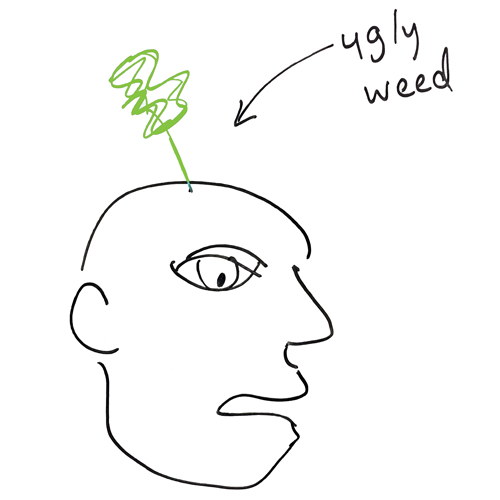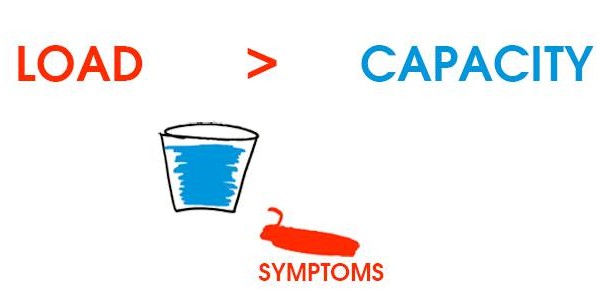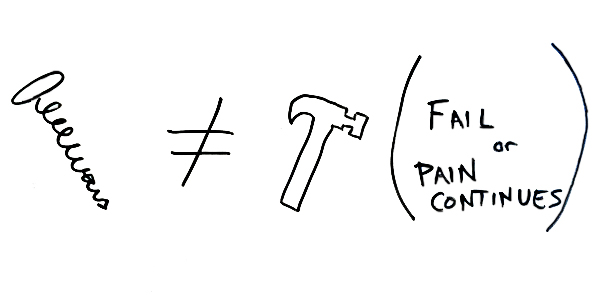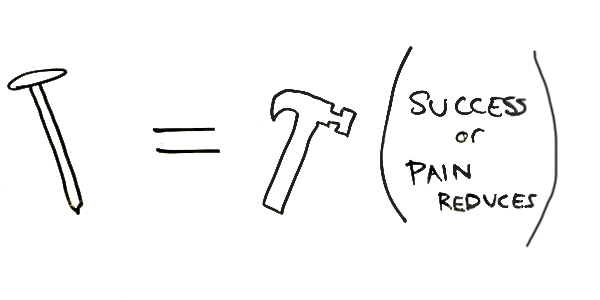
09 Aug You Can’t Workout to Compensate for A Lack of Mental and Emotional Health
Author’s Note: This post discusses mental and emotional health in the context of health and fitness pursuits. I discuss the path of chronic pain when individuals are allowed + enabled to ignore deeper psychological issues. This perspective comes from my daily work with individuals who pay me to get out of pain.
I was watching a video on improving the squat.
The speaker was suggesting:
- Accumulating 60 minutes of time spent in the bottom of a squat
- Accumulating 30 minutes of time spent in the bottom of a lunge with the front foot on top of a 45 pound plate
- Doing a handful of lateral step-ups each week
I thought to myself:
That’s good advice for improving the ability to squat.
Then, I wondered:
How many people viewing this video truly need to increase their performance to the max?
How many people who workout are pushing their performance too far + seeking benefits too quickly, where the cost (or risk) of increased damaging, harm, or abuse exceeds the pursued benefit?
How many people use workouts as a means to stress management + increasing self worth like I used to?
How many people are doing more harm than good?
What’s life like for the adult, American athlete in the moment?
Let’s paint a picture.
Whoever you are, you work hard at life. After all, that’s the American way.
In your job.
At home.
In your relationships.
It’s OK though, because you have your time at the gym. Or your time on the bike or in your running sneakers. It’s your stress management. The thing that keeps you going every day. Your opportunity to get out of your head + experience the flow. To be fully present for 60 minutes that is just for you.
No boss. No kids. No spouse.
It’s all yours.
And its great because it helps you be healthier too (or so you think). You’ve lost weight since you started your current fitness routine. Maybe you even see an ab peaking out here or there. Perhaps you’ve noticed more attention from the opposite sex. Your energy has increased + so has your confidence.
It’s all gravy.
What’s life like for the adult, American athlete in the future?
Until it’s not.
I’m talking about the pain that has increased in magnitude, duration, + impact on your ability to do that thing you love.
Maybe it’s currently minor + is nothing more than an annoyance. Or maybe you’ve already sought care, found that nobody could offer you real perspective or results, so you continued doing that thing that brought upon the pain.
How do you plead?
Ignorance.
When your pain grows to the point that you cannot do the thing that brought you fitness, health, happiness, or stress relief in the past, that’s usually when your world comes crashing down.
You can no longer ignore your body’s signals.
Thing is, it’s inevitable when you push your fitness too hard + too fast.
When your pain is the only thing you can see, whether you’re working out or doing nothing on a daily basis, you’ve reached the fork in the road.
Katie’s Story: When the Body Shuts Down
Katie is my girlfriend + better half. 
I heal people physically.
Katie heals people emotionally, mentally, + spiritually through Reiki, Sound Healing, and her 10 week Happier program.
A few years ago when she opened Heroes Journey, Katie was going through a divorce while waking up at 6 AM to coach classes, doing high-intensity CrossFit WODs, then leaving the gym at 8 PM before going home.
Eventually, Katie noticed surmounting stressed in her life. She was having trouble controlling her emotions. Her psoriasis was having outbreaks, even when she wasn’t eating poorly.
The tipping point occurred when she was coaching 15-20 people in class, demonstrating a movement, when she literally crumbled to the ground, fainting due to the stress.
This happened twice before she got the hint.
She didn’t know how the mental and emotional load was affecting her health.
Katie didn’t have the capacity to handle the load of more physical stress with CrossFit workouts.
Today, Katie is not fully recovered yet, although much improved from that time. She works out.
Slowly. Methodically.
Only pushing when she has the capacity to do so. If she does a high-intensity WOD when her stress bucket is tipping over, she’ll sleep 12 hours a night for a week as her body recovers.
Katie is an example of what it looks like you workout to deal with mental and emotional stress, causing disease instead of health.
Now, Katie is a crusader alongside Barefoot Rehab for whole health human beings – physically, mentally, emotionally, and spiritually.
It’s Time to Reflect When Pain Is Growing
If you’ve been to 3-5 other healthcare providers + you’re still hurting, you’re probably about to step foot into our office at Barefoot Rehab.
Most of our patients have just about lost hope.
Our new patient forms are extensive + sometimes seen as annoying. However, it’s what is necessary to collect the puzzle pieces of your pain picture.
The doctors eventually come upon the load questions:
- How much are you currently doing?
- What have you been doing?
- How has this changed compared with what you’ve done in the past?
What is obvious to the questioning doctor that isn’t obvious to the hurting patient is:
All pain is a result of load exceeding capacity.
Every time. 100% of the time.

Therefore, in order to heal + recover, the controllable variable of movement load needs to increase to allow for space in one’s capacity bucket for treatment load.
That means to stop working out or at minimum, to cut back.
That’s also when you give the doctor the “F*** You” look without saying it.
When I see that look, I know it’s time for a conversation.
It always involves some form of psychological questioning. I don’t like using absolute words like “always” or “never” but the people who push ridiculously hard, despite increasing chronic pain, are almost always hiding mental and emotional health scars that they’ve never allowed to heal.
In the book Untethered Soul (affiliate link), Michael Singer points to our defensive mechanisms as thick, metal-plated armor that are designed to not let anyone rub up on our wounds. When your cut is healing, it gets irritated when you touch it.
The question becomes “What do I need to do to let this mental and emotional health wound heal?”
Mental and Emotional Health Wounds Need Mental and Emotional Health Answers
When you have a screw, you cannot use a hammer.
You’d fail at solving the problem of the screw.

However, grab a hammer when you have a nail + you’ve used the exact, precise, gold-standard tool for the implement at hand.

I cannot solve a mental and emotional health problem with adhesion removal.

I wish I could. I’d be rich.
But I can’t. That’s not reality.
The weed of a health problem needs excavation, not the runner’s high, a sweat angel, or an endorphin rush to plant the annual flowers that will be gone from the mind in a day. (For those of you who don’t garden, annual flowers need to be planted year after year while perennial flowers are planted once, then continue to grow, year after year.)
Mental and emotional health wounds need mental and emotional healing.
Psycho-therapeutic techniques act like a shovel for your ugly thought weed.

My current list of psycho-therapeutic healing techniques that have impacted me includes:
- journalling
- meditation
- mindfulness
- energy healing (Katie Leiher + Jason Wood practice in Parsippany + Hawthorne, New Jersey, respectively)
- Positive Psychology (Katie Leiher runs 2-3 month Happier programs + Emiliya Zhivotovskaya runs longer Certifications in Applied Positive Psychology)
- conventional, Freudian psychotherapy
- Imago Therapy for couples (Stephanie St. Cyr practices in Morristown, New Jersey)
- archetypal dreamwork (Jill Eras practices over Skype or in-person in New Jersey)
- journalling through The Artist’s Way (affiliate link)
- medicine ceremonies through Ayahuasca or even my own personal experimentation with psychadelic mushrooms + the active molecule psilocybin
- Landmark Worldwide
For my own wounds, I’ve found all of the above to be effective in various ways. You can research the areas above, find your own things that work through your own networks, or not doing anything for your head wounds.
Naming a problem what it is allows the individual at the painful fork in the road to make a decision that is empowered when it comes to all aspects of one’s health, fitness, + happiness.
With no regrets.
 Do you workout as a substitute for your mental and emotional health? How is that going so far? What are you ready to pursue as another method to heal your non-physical wounds?
Do you workout as a substitute for your mental and emotional health? How is that going so far? What are you ready to pursue as another method to heal your non-physical wounds?

Gerry Maley
Posted at 05:14h, 03 MayHey Chris
I have pain above my knee cap both knees, morning only and eases when I have warmed up (just walking about).
I cut back on squat type exercise and am back on the bike (50miles ok) and doing lots of stretching…
But still sore, stiff in the morning.
Any advice?
Dr. Chris
Posted at 16:39h, 03 MaySounds like quadriceps tendinosis or osteoarthritis, depending on the exact location. The younger you are, the more likely the former. What’s your range with this test (https://www.barefootrehab.com/know-your-numbers-face-up-heel-to-butt-test/)?